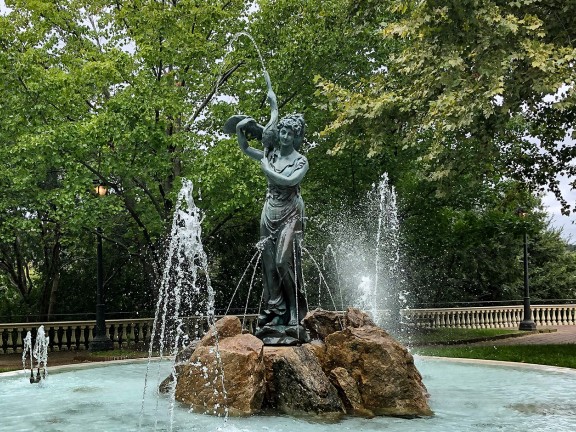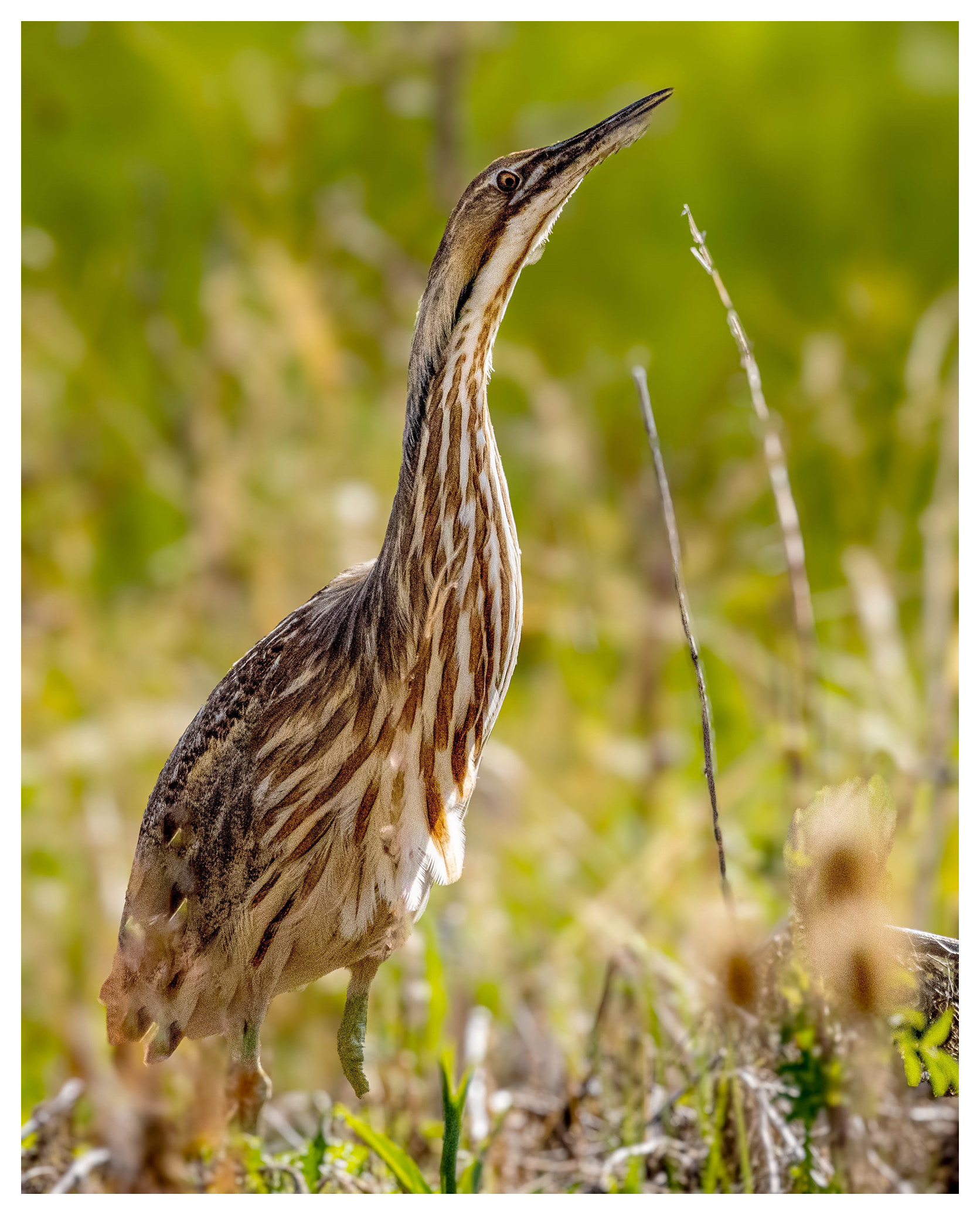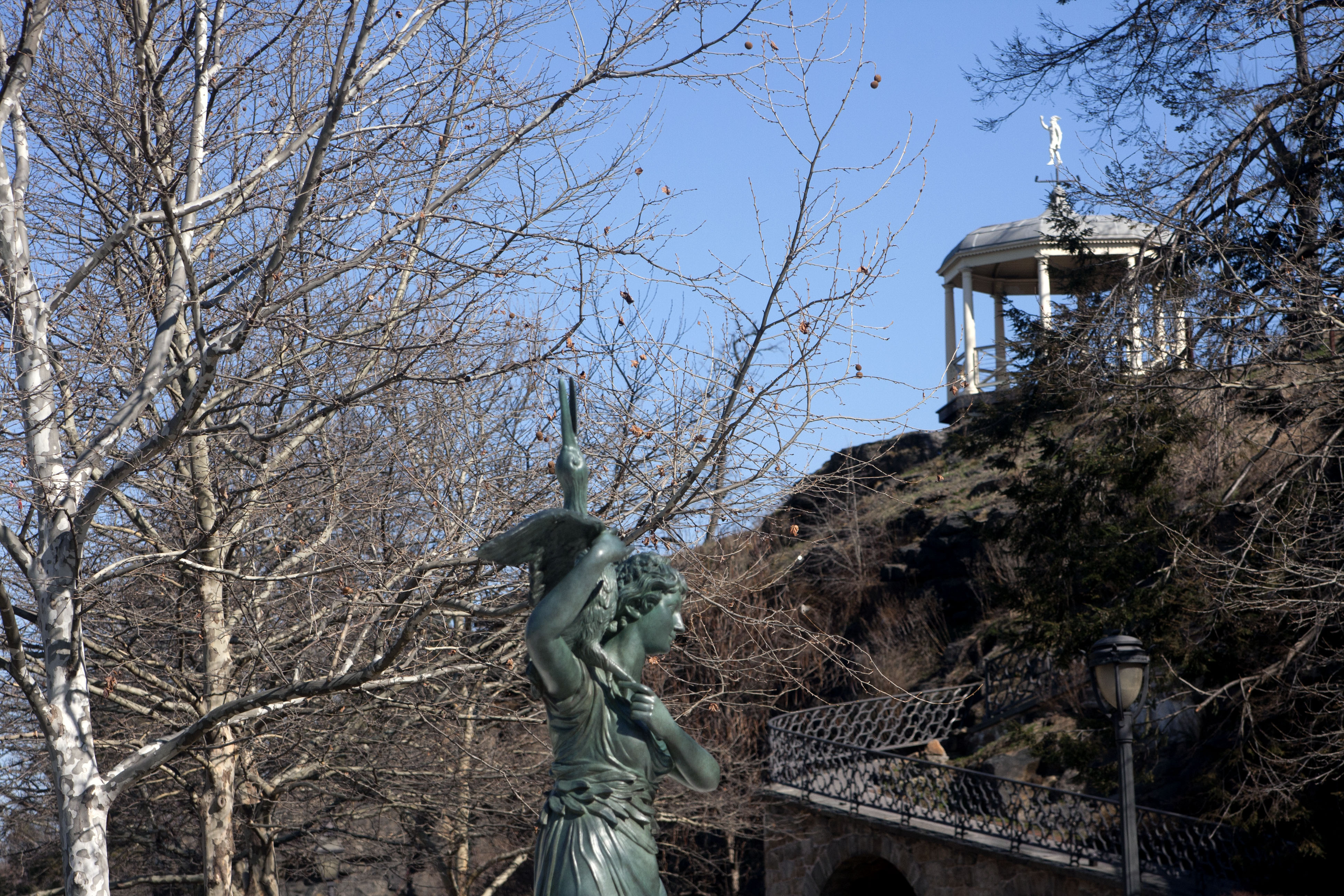Allegory of the Schuylkill River (Water Nymph and Bittern)

You may have noticed the fountain downriver of the Fairmount Water Works Interpretive Center (FWW) is operational again after being off for some time. This is because Philadelphia Parks and Recreation (PPR) recently rebuilt the fountain’s pumps and filtration system – thank you PPR! Seeing water rhythmically arching from the bittern’s beak once again (and at the suggestion of a trail user), we thought it timely to dive into the history of the fountain and its center statue, Allegory of the Schuylkill River (Water Nymph and Bittern), which is pictured above.
The Nation's First Public Water Fountain
As you know, Philadelphia is a city of firsts – first ice cream, first library, first slinky, first botanic garden (which you can visit while exploring Bartram’s Mile) – learn about other Philly firsts here. Arguably, one of the most important firsts is the municipal water system. Starting in 1801, water from the Schuylkill River was transported through underground aqueducts to Centre Square Pump House, which was located where City Hall is located today. From there, water was distributed to customers around the city. Along with the pump house was a decorative public water fountain with a wooden statue of a woman and bittern that was created in 1809 by William Rush (1756-1833), America’s first significant sculptor. Carved from live model Louisa Vanuxem, the piece was originally painted white to emulate antique marble statues and may symbolize the domestication of water to serve the city’s residents.
Above image of oil painting by John Lewis Krimmel, Fourth of July in Centre Square, 1812. Allegory of the Schuylkill River (Water Nymph and Bittern) is the center statue. Image provided by Pennsylvania Academy of the Fine Arts.
By 1815, the pump house required significant maintenance, prompting the City to rethink and relocate its water system to the edge of the Schuylkill River at what is now the FWW. The pump house was eventually demolished in 1829 and Rush’s decorative statue was relocated to a fountain in the South Garden of the FWW. By 1872, the wooden statue had considerably deteriorated and the City had it recast in bronze. Only the head of the original statue remains and is in the collection of the Pennsylvania Academy of the Fine Arts.
Throughout the end of the 1800’s, Philadelphia’s population grew, the Schuylkill River became choked with pollution, and communicable and waterborne diseases proliferated. In response, the City began treating water through sand filtration systems at five plants located around the city and decommissioned the FWW in 1909. Due to the subsequent decline of the FWW, the Allegory of the Schuylkill River (Water Nymph and the Bittern) was removed from its fountain in the South Garden and placed into storage in 1937.
Eight decades later, PPR and Fairmount Park Conservancy received a grant from the William B. Dietrich Foundation to recreate (rather than restore) the Allegory of the Schuylkill River (Water Nymph and Bittern) as well as Rush’s Mercury, which sits on top of the Mercury Pavilion. The new statue, which is the version you see today, was cast in silicon bronze and should stand up to the elements for generations.
Make sure to add the South Garden and adjoining Cliff Path (which are easily accessible from the northern end of Schuylkill Banks!) to your next trail adventure and view two of the city’s oldest public works of art.
Image of Rush's two statues viewed from the South Garden provided by Fairmount Park Conservancy.
More on the Artist and Related Statues
William Rush served in the Revolutionary War and eventually started a wood carving business primarily for maritime vessels. This work led him to carve figureheads for the Navy’s warships. Rush’s work could be seen across Philadelphia at the Chestnut Street Theatre, the Masonic Temple, and Independence Hall. Along with other artists and business leaders, Rush helped found the Pennsylvania Academy of Fine Arts in 1805. Rush is interred at The Woodlands in Southwest Philadelphia along with other notable Philadelphians.
In addition to Mercury and Allegory of the Schuylkill River (Water Nymph and Bittern), Rush has two other sculptures related to the Schuylkill River displayed above the FWW’s two entryways, The Schuylkill Chained (originally Allegory of the Schuylkill River in Its Improved State) and The Schuylkill Freed (originally Allegory of the Waterworks). The Schuylkill Chained is a long haired, seemingly distraught, Paganesque man chained in a reclining position with an American Eagle at his feet. The Schuylkill Freed is a woman with a clean topknot lounging next to a water wheel and a fountain.
Allegory of the Schuylkill River (Water Nymph and Bittern) Revisited
Around the time Rush’s wooden statue was replaced by the first bronze version, prominent Philadelphian artist Thomas Eakins (1844-1916) painted William Rush Carving His Allegorical Figure of the Schuylkill River. According to Ken Finkel in The Philly History Blog “William Rush and What’s Left of the Nymph,” Eakins wanted to believe that Rush carved his statue from a live model that was nude and depicted this scene in his painting and subsequent paintings on the topic. According to Finkel, “The popularity of the young, lithe, barely-clad female figure was undisputed, and became legendary. In addition to depictions in prints and paintings, the rowdy members of the Fairmount Fire Company adopted her image as a logo. They wore it proudly on their ceremonial hats.”

Above Left Image: Oil painting by Thomas Eakins, William Rush Carving His Allegorical Figure of the Schuylkill River, 1876–77. Image provided by the Philadelphia Museum of Art, https://philamuseum.org/collection/object/42507. Above Right Image: National Museum of American History, Smithsonian Institution. “Smithsonian Learning Lab Resource: Fairmount Fire Company Fire Hat.” Smithsonian Learning Lab, Smithsonian Office of Educational Technology, 31 Oct. 2015, https://learninglab.si.edu/q/r/59228
What is a bittern? 
The bittern in Rush’s statue is presumably an American Bittern (pictured here), which is a type of heron that prefers to spend time hunting in marshy habitats. Much like the sculpture displays, the bird often holds its head high and neck extended, utilizing the stripes on its neck to camouflage itself among reeds. Bitterns have a distinctive breeding call that sounds like a loud ‘BLOOP,’ which you can listen to here. Grab your birding gear (or get some on loan from the Free Library) and head to the marshy areas at FDR Park and John Heinz Wildlife Refuge at Tinicum for a chance to spot and hear this “cryptically-colored heron,” which can be hard to spot in their habitat so listen for a loud BLOOP!
Image Credit: American Bittern Standing, Lane Wintermute/USFWS, Public Domain, https://www.fws.gov/media/american-bittern-standing
![Fourth of July in [Philadelphia’s] Centre Square](/sites/default/files/inline-images/4th%20of%20July%20at%20Centre%20Square.jpg)



